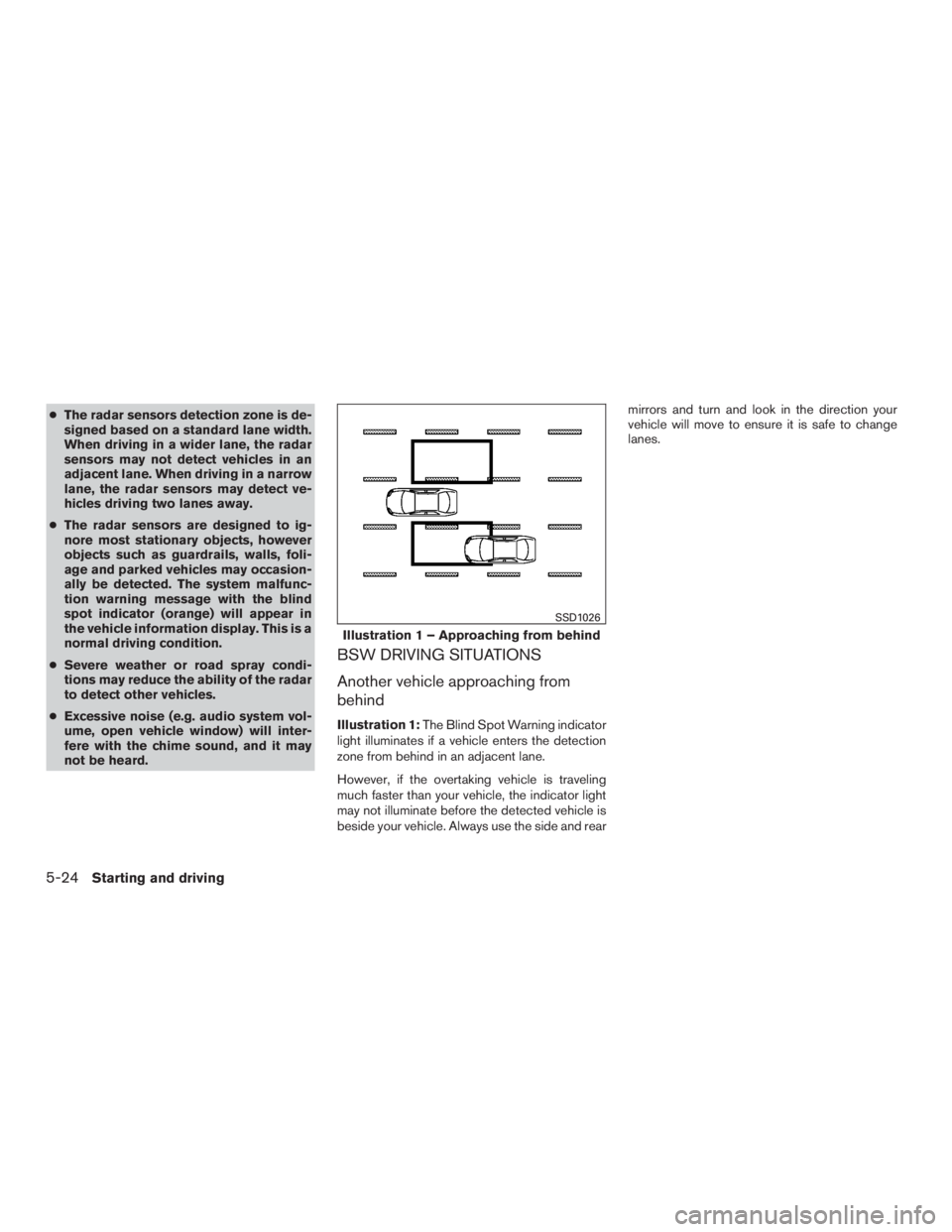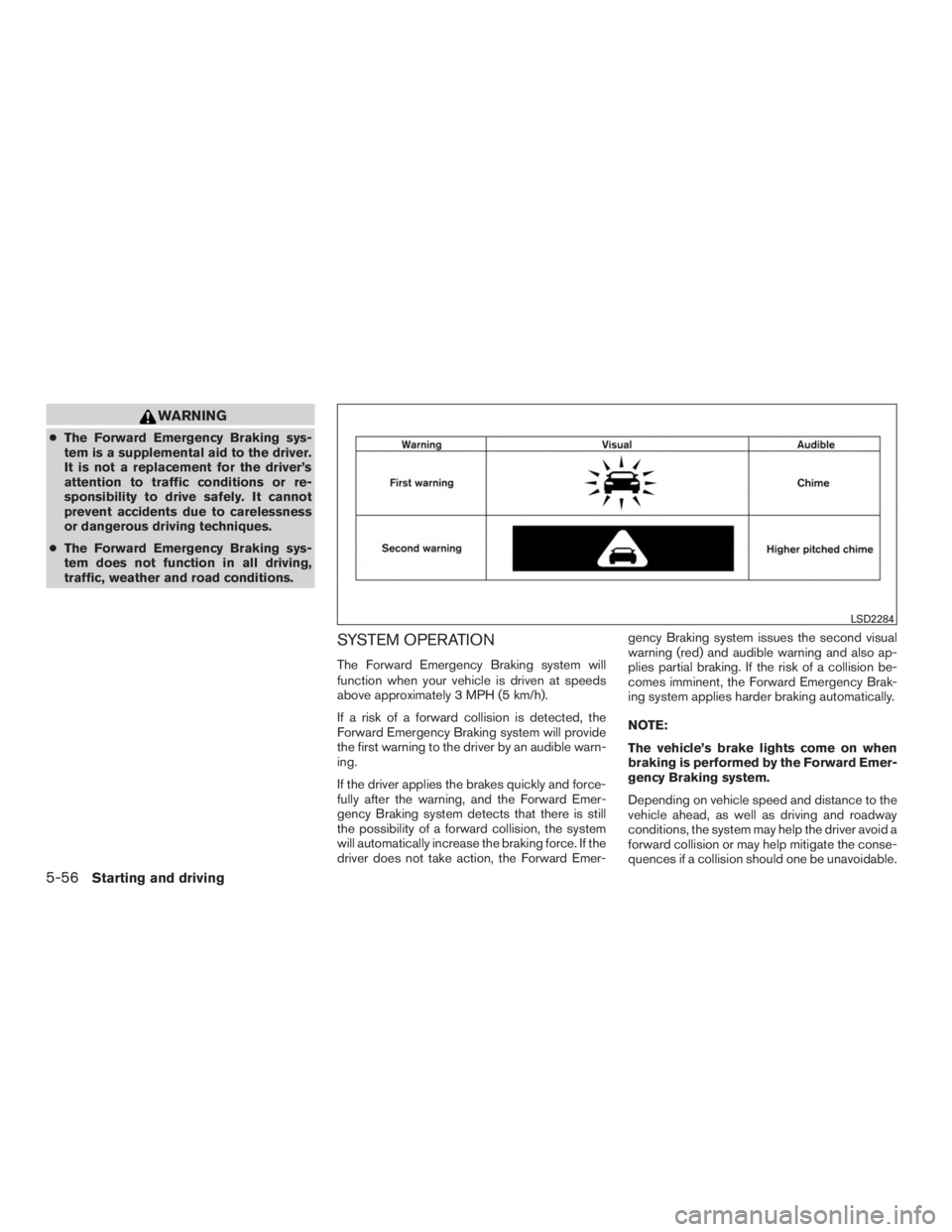Page 273 of 424

●The radar sensors detection zone is de-
signed based on a standard lane width.
When driving in a wider lane, the radar
sensors may not detect vehicles in an
adjacent lane. When driving in a narrow
lane, the radar sensors may detect ve-
hicles driving two lanes away.
● The radar sensors are designed to ig-
nore most stationary objects, however
objects such as guardrails, walls, foli-
age and parked vehicles may occasion-
ally be detected. The system malfunc-
tion warning message with the blind
spot indicator (orange) will appear in
the vehicle information display. This is a
normal driving condition.
● Severe weather or road spray condi-
tions may reduce the ability of the radar
to detect other vehicles.
● Excessive noise (e.g. audio system vol-
ume, open vehicle window) will inter-
fere with the chime sound, and it may
not be heard.
BSW DRIVING SITUATIONS
Another vehicle approaching from
behind
Illustration 1: The Blind Spot Warning indicator
light illuminates if a vehicle enters the detection
zone from behind in an adjacent lane.
However, if the overtaking vehicle is traveling
much faster than your vehicle, the indicator light
may not illuminate before the detected vehicle is
beside your vehicle. Always use the side and rear mirrors and turn and look in the direction your
vehicle will move to ensure it is safe to change
lanes.
Page 276 of 424
Entering from the side
Illustration 7:The Blind Spot Warning indicator
light illuminates if a vehicle enters the detection
zone from either side.
NOTE:
The radar sensors may not detect a vehicle
which is traveling at about the same speed
as your vehicle when it enters the detection
zone. Illustration 8:
Illustration 8: If the driver acti-
vates the turn signal while another vehicle is in the
detection zone the Blind Spot Warning indicator
light flashes and a chime will sound twice.
NOTE:
If the driver activates the turn signal before
a vehicle enters the detection zone, the
Blind Spot Warning indicator light will flash
but no chime will sound when another ve-
hicle is detected.
Page 285 of 424

WARNING
●As there is a performance limit to the
distance control function, never rely
solely on the Intelligent Cruise Control
system. This system does not correct
careless, inattentive or absent-minded
driving, or overcome poor visibility in
rain, fog, or other bad weather. Deceler-
ate the vehicle speed by depressing the
brake pedal, depending on the distance
to the vehicle ahead and the surround-
ing circumstances in order to maintain a
safe distance between vehicles.
● If the vehicle ahead comes to a stop, the
vehicle decelerates to a standstill
within the limitations of the system. The
system will cancel once it judges that
the vehicle has come to a standstill and
sound a warning chime. To prevent the
vehicle from moving, the driver must
depress the brake pedal.
● The system may not detect the vehicle
in front of you in certain road or weather
conditions. To avoid accidents, never
use the Intelligent Cruise Control sys-
tem under the following conditions:
– On roads where the traffic is heavy or there are sharp curves – On slippery road surfaces such as on
ice or snow, etc.
– During bad weather (rain, fog, snow, etc.)
– When rain, snow or dirt adhere to the bumper around the distance sensor
– On steep downhill roads (the vehicle may go beyond the set vehicle speed
and frequent braking may result in
overheating the brakes)
– On repeated uphill and downhill roads
– When traffic conditions make it diffi- cult to keep a proper distance be-
tween vehicles because of frequent
acceleration or deceleration
– Interference by other radar sources.
● Do not use the Intelligent Cruise Con-
trol system if you are towing a trailer.
The system may not detect a vehicle
ahead. ●
In some road or traffic conditions, a
vehicle or object can unexpectedly
come into the sensor detection zone
and cause automatic braking. You may
need to control the distance from other
vehicles using the accelerator pedal. Al-
ways stay alert and avoid using the ICC
system where not recommended in this
warning section.
5-36Starting and driving
Page 291 of 424
●When the shift lever is not in the D (Drive) or
Manual mode
● When the parking brake is applied
● When the brakes are operated by the driver
When the SET/COAST (–) switch is pushed
under the following conditions, the system can-
not be set.
A warning chime will sound and a message will
pop up. ● When the VDC system is off (To use the ICC
system, turn on the VDC system. Push the
CRUISE ON/OFF switch to turn off the ICC
system and reset the ICC switch by pushing
the CRUISE ON/OFF switch again.)
For additional information about the VDC
system, refer to “Vehicle Dynamic Control
(VDC) system” in this section.
● When ABS or VDC (including the TCS) is
operating
● When a wheel is slipping (To use the ICC
system, make sure the wheels are no longer
slipping. Push the CRUISE ON/OFF switch
to turn off the ICC, and reset the ICC system
by pushing the CRUISE ON/OFF switch
again.)
�1System set display with vehicle ahead
�2System set display without vehicle ahead
System operation
Page 299 of 424
Precautions on the Predictive Forward
Collision Warning system
Page 300 of 424
WARNING
●The Predictive Forward Collision Warn-
ing system does not function when a
vehicle ahead is a narrow vehicle, such
as a motorcycle. The radar sensor may
not detect a second vehicle ahead in the
following conditions:
– Snow or heavy rain.
– Dirt, ice, snow or other material cov- ering the radar sensor.
– Interference by other radar sources. – Snow or road spray from travelling
vehicles.
– Driving in a tunnel.
Page 302 of 424
WARNING
●The radar sensor may not detect a sec-
ond vehicle when the vehicle ahead is
being towed.
● When the distance to the vehicle ahead
is too close, the beam of the radar sen-
sor is obstructed.
● The radar sensor may not detect a sec-
ond vehicle when driving on a steep
downhill slope or on roads with sharp
curves. ●
Excessive noise will interfere with the
warning tone sound, and it may not be
heard.System temporarily unavailable
Condition A:
When the radar sensor picks up interference
from another radar source, making it impossible
to detect a vehicle ahead, the Predictive Forward
Collision Warning system is automatically turned
off.
The Forward Emergency Braking system warning
light (orange) and the driver assist system for-
ward indicator (orange) will illuminate.
Page 305 of 424

WARNING
●The Forward Emergency Braking sys-
tem is a supplemental aid to the driver.
It is not a replacement for the driver’s
attention to traffic conditions or re-
sponsibility to drive safely. It cannot
prevent accidents due to carelessness
or dangerous driving techniques.
● The Forward Emergency Braking sys-
tem does not function in all driving,
traffic, weather and road conditions.
SYSTEM OPERATION
The Forward Emergency Braking system will
function when your vehicle is driven at speeds
above approximately 3 MPH (5 km/h).
If a risk of a forward collision is detected, the
Forward Emergency Braking system will provide
the first warning to the driver by an audible warn-
ing.
If the driver applies the brakes quickly and force-
fully after the warning, and the Forward Emer-
gency Braking system detects that there is still
the possibility of a forward collision, the system
will automatically increase the braking force. If the
driver does not take action, the Forward Emer- gency Braking system issues the second visual
warning (red) and audible warning and also ap-
plies partial braking. If the risk of a collision be-
comes imminent, the Forward Emergency Brak-
ing system applies harder braking automatically.
NOTE:
The vehicle’s brake lights come on when
braking is performed by the Forward Emer-
gency Braking system.
Depending on vehicle speed and distance to the
vehicle ahead, as well as driving and roadway
conditions, the system may help the driver avoid a
forward collision or may help mitigate the conse-
quences if a collision should one be unavoidable.